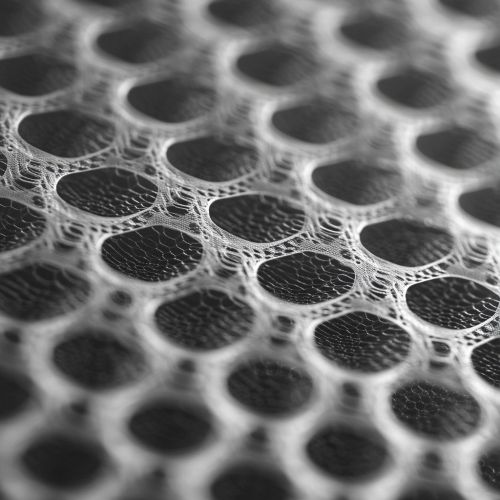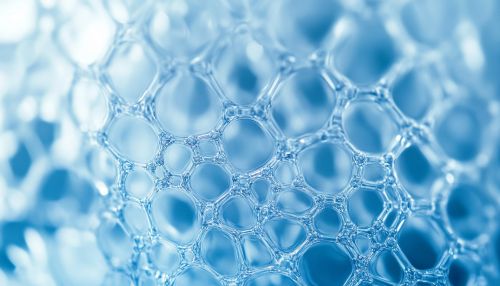Nanotechnology in Water Filtration: Difference between revisions
(Created page with "== Introduction == Nanotechnology in water filtration represents a cutting-edge approach to addressing the global challenge of providing clean and safe drinking water. This technology leverages the unique properties of materials at the nanoscale to enhance the efficiency and effectiveness of water purification processes. By utilizing nanoparticles and nanostructured materials, nanotechnology offers innovative solutions for removing contaminants, pathogens, and pollutant...") |
No edit summary |
||
| Line 43: | Line 43: | ||
* **Dendrimers**: These highly branched polymeric structures can encapsulate and remove specific pollutants through chemical interactions. | * **Dendrimers**: These highly branched polymeric structures can encapsulate and remove specific pollutants through chemical interactions. | ||
[[Image:Detail-98489.jpg|thumb|center|Close-up of a nanostructured membrane used in water filtration, showing intricate patterns and textures.|class=only_on_mobile]] | |||
[[Image:Detail-98490.jpg|thumb|center|Close-up of a nanostructured membrane used in water filtration, showing intricate patterns and textures.|class=only_on_desktop]] | |||
== Applications of Nanotechnology in Water Filtration == | == Applications of Nanotechnology in Water Filtration == | ||
Latest revision as of 18:23, 16 October 2024
Introduction
Nanotechnology in water filtration represents a cutting-edge approach to addressing the global challenge of providing clean and safe drinking water. This technology leverages the unique properties of materials at the nanoscale to enhance the efficiency and effectiveness of water purification processes. By utilizing nanoparticles and nanostructured materials, nanotechnology offers innovative solutions for removing contaminants, pathogens, and pollutants from water sources. This article delves into the mechanisms, applications, and potential impacts of nanotechnology in water filtration, providing a comprehensive overview of its role in modern water treatment systems.
Principles of Nanotechnology in Water Filtration
Nanotechnology involves manipulating matter at the atomic and molecular scale, typically within the range of 1 to 100 nanometers. At this scale, materials exhibit unique physical, chemical, and biological properties that differ significantly from their bulk counterparts. These properties are harnessed in water filtration to achieve superior performance in contaminant removal.
Mechanisms of Action
Nanotechnology in water filtration operates through several mechanisms:
- **Adsorption**: Nanomaterials such as carbon nanotubes and graphene oxide have high surface areas and can adsorb a wide range of contaminants, including heavy metals and organic compounds. The adsorption process involves the binding of contaminants to the surface of the nanomaterials, effectively removing them from the water.
- **Catalysis**: Nanoparticles like titanium dioxide (TiO2) can act as photocatalysts, breaking down organic pollutants into harmless byproducts under UV light. This process, known as photocatalysis, is particularly effective for degrading persistent organic pollutants.
- **Membrane Filtration**: Nanostructured membranes, such as those made from nanofibers or incorporating nanoparticles, offer enhanced filtration capabilities. These membranes can selectively remove contaminants based on size exclusion, charge interactions, or affinity for specific molecules.
- **Antimicrobial Activity**: Certain nanoparticles, such as silver and zinc oxide, exhibit antimicrobial properties that can inactivate bacteria, viruses, and other pathogens in water. This antimicrobial action is crucial for ensuring microbiologically safe drinking water.
Types of Nanomaterials Used in Water Filtration
A variety of nanomaterials are employed in water filtration systems, each offering distinct advantages and applications:
Carbon-Based Nanomaterials
- **Carbon Nanotubes (CNTs)**: CNTs are cylindrical structures with exceptional mechanical strength and high surface area, making them effective for adsorbing organic pollutants and heavy metals. Their electrical conductivity also allows for electrochemical applications in water treatment.
- **Graphene and Graphene Oxide**: Graphene's single-layer structure provides a large surface area and high chemical stability, suitable for adsorbing a wide range of contaminants. Graphene oxide, with its oxygen-containing functional groups, enhances interaction with pollutants.
Metal and Metal Oxide Nanoparticles
- **Silver Nanoparticles**: Known for their antimicrobial properties, silver nanoparticles are used to disinfect water by inactivating a broad spectrum of microorganisms.
- **Titanium Dioxide (TiO2) Nanoparticles**: TiO2 is a widely used photocatalyst for degrading organic pollutants. Its ability to generate reactive oxygen species under UV light makes it effective for breaking down complex contaminants.
- **Iron Oxide Nanoparticles**: These nanoparticles are employed for removing heavy metals and arsenic from water through adsorption and magnetic separation techniques.
Polymeric Nanomaterials
- **Nanofibers**: Electrospun nanofibers can be engineered to have specific pore sizes and surface functionalities, allowing for tailored filtration of contaminants.
- **Dendrimers**: These highly branched polymeric structures can encapsulate and remove specific pollutants through chemical interactions.


Applications of Nanotechnology in Water Filtration
Nanotechnology has been integrated into various water treatment processes, offering solutions for both large-scale municipal systems and point-of-use applications.
Municipal Water Treatment
In municipal water treatment plants, nanotechnology is used to enhance existing processes such as coagulation, sedimentation, and filtration. Nanomaterials can improve the removal of contaminants that are challenging to eliminate with conventional methods, such as pharmaceuticals and endocrine-disrupting compounds.
Point-of-Use Systems
Nanotechnology enables the development of compact and efficient point-of-use water filtration systems. These systems, often designed for household or portable use, can provide safe drinking water in remote or resource-limited areas. Nanomaterials are incorporated into filters, cartridges, and purification devices to ensure effective contaminant removal.
Industrial Wastewater Treatment
Industries generate wastewater containing a variety of pollutants, including heavy metals, organic compounds, and dyes. Nanotechnology offers advanced treatment options for industrial wastewater, allowing for the recovery of valuable resources and minimizing environmental impact.
Challenges and Limitations
Despite the promising potential of nanotechnology in water filtration, several challenges and limitations must be addressed:
Environmental and Health Concerns
The release of nanoparticles into the environment poses potential risks to ecosystems and human health. Understanding the fate, transport, and toxicity of nanomaterials is crucial for ensuring safe and sustainable applications.
Cost and Scalability
The production and integration of nanomaterials into water filtration systems can be costly. Developing cost-effective manufacturing processes and scalable technologies is essential for widespread adoption.
Regulatory and Standardization Issues
The lack of standardized testing methods and regulatory frameworks for nanotechnology in water filtration presents challenges for commercialization. Establishing guidelines and standards is necessary to ensure the safety and efficacy of nanotechnology-based solutions.
Future Prospects
The future of nanotechnology in water filtration is promising, with ongoing research and development aimed at overcoming current limitations and expanding applications.
Advanced Material Design
Researchers are exploring novel nanomaterials with enhanced properties for specific applications. Innovations in material synthesis and functionalization are expected to lead to more efficient and selective filtration systems.
Integration with Other Technologies
Combining nanotechnology with other advanced technologies, such as membrane bioreactors and advanced oxidation processes, can create synergistic effects and improve overall water treatment performance.
Sustainable and Green Approaches
Efforts are being made to develop environmentally friendly nanomaterials and processes. Utilizing renewable resources and minimizing energy consumption are key goals for sustainable water filtration technologies.
